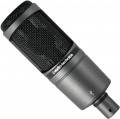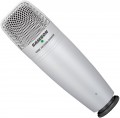Directional pattern
The polar pattern of a unidirectional microphone (see above). There are models with
DN switching.
By itself, such a diagram is a graph of sensitivity versus direction, built in the so-called polar coordinate system. For unidirectional models, there are three main options for the shape of the line on such a chart:
—
Cardioid. A chart shaped like an inverted heart symbol (hence the name). Microphones with these characteristics cover a fairly large area in front, which makes it difficult to filter out extraneous sound sources that are close to the main source. At the same time, they are completely insensitive to sound coming from the rear.
—
Supercardioid. These mics have a narrower front coverage than "classic" cardioid mics, making it easier to pick up directional sound. The downside of this is some (albeit rather low) sensitivity to sound coming directly from behind.
—
Hypercardioid. The hypercardioid pattern further narrows the microphone's sensitivity zone in the front (compared to the supercardioid pattern), but widens this zone in the back.
Rated resistance
Microphone AC impedance; this parameter is also called "impedance". This is one of the most important characteristics that determines compatibility with the amplifier or other device to which the microphone is connected: if the impedance is not optimal, there may be a loss in signal power. It has its own characteristics, depending on the purpose of a particular model (see above). So, for microphones used with computers, laptops, voice recorders and phones / tablets, the impedance may not be indicated at all — the characteristics of such models are selected in such a way as to ensure normal compatibility with the corresponding devices. But in professional audio equipment, special rules are used for selection; more details can be found in special sources.
Frequency range
The range of audio frequencies normally perceived and processed by a microphone.
The wider this range — the fuller the signal, the less likely that too high or low frequencies will be missed due to the imperfection of the microphone. However, in this case, it is worth considering some nuances. First of all: a wide frequency range in itself does not guarantee high sound quality — a lot also depends on the type of microphone (see above) and its frequency response, not to mention the quality of other components of the audio system. In addition, a large width is also not always really necessary. For example, for normal transmission of human speech, a range of 500 Hz — 2 kHz is considered sufficient, which is much narrower than the general range perceived by the human ear. This general range, in turn, averages from 16 Hz to 22 kHz, and also narrows with age. Do not forget about the features of the equipment to which the microphone is connected: it is hardly worth specifically looking for a model with an extensive range, if, for example, the amplifier to which it is planned to be connected severely “cuts off” the frequencies from above and/or below.
Sensitivity
Sensitivity describes the signal strength at the output of a microphone when it processes a sound of a certain volume. In this case, sensitivity means the ratio of the output voltage to the sound pressure on the membrane, expressed in decibels. The higher this number, the higher the sensitivity. Note that, as a rule, values in decibels are negative, so we can say this: the closer the number is to zero, the more sensitive the microphone. For example, a -38 dB model outperforms a -54 dB model in this parameter.
It should be borne in mind that high sensitivity in itself does not mean high sound quality - it only allows the device to “hear” a weaker sound. Conversely, low sensitivity is not an unequivocal sign of a bad microphone. The choice for this parameter depends on the specifics of the application: a sensitive device is useful for working with low sounds and in cases where it is necessary to capture the smallest nuances of what is happening, and a “weak” microphone will be convenient at high sound volume or, if necessary, filter out extraneous weak noises. There are models with
sensitivity adjustment(and for models with a headphone output
, headphone volume control may be provided).
Sound pressure
The maximum sound pressure perceived by the microphone, at which the harmonic oscillation coefficient does not exceed 0.5% — in other words, the highest sound volume at which no noticeable interference occurs.
The higher this indicator, the better the microphone is suitable for working with loud sound. Here it is worth considering that the decibel is a non-linear quantity; in other words, an increase in volume from 10 dB to 20 dB or from 20 to 40 dB does not mean a 2-fold increase in volume. Therefore, when assessing, it is most convenient to refer to comparative tables of noise levels. Here are some examples: a level of 100 dB roughly corresponds to a motorcycle engine or subway car noise; 110 dB — helicopter; 120 dB — the work of a demolition hammer; 130 dB, comparable to the sound of a jet aircraft taking off, is considered a pain threshold for a person. At the same time, many high-end microphones are able to work normally at a sound pressure of 140 – 150 dB — and this is a noise level that can cause physical damage to a person.
Signal to noise ratio
A parameter that describes the relationship between the useful signal level and the noise level produced by the microphone. Note that the actual signal-to-noise ratio varies depending on the sound pressure perceived by the microphone. Therefore, in the characteristics it is customary to indicate the option for a standard situation — at a sound pressure of 94 dB. This allows you to compare different models with each other.
In general, this indicator quite clearly characterizes the quality of work of a particular model, since it takes into account almost all significant extraneous noise that occurs during operation. The greater this ratio, the clearer the sound is, the less distortion it has. Values of 64 – 66 dB are considered quite decent, and high-end microphones provide performance of 72 dB and higher.
ADC sampling rate
The sampling rate of the analogue-to-digital converter (ADC) provided in the design of the microphone.
An ADC is a module responsible for converting an analogue signal coming from a microphone capsule into a digital format. It is used mainly in models connected via digital interfaces — for example, USB (see below) — and also in some wireless ones, where the digital format is used for radio communication.
The principle of analogue-to-digital conversion is that the analogue signal is divided into separate fragments, each of which is encoded with its own numerical value. If this is depicted graphically, then the graph of the analogue signal looks like a smooth line, and the digital signal looks like a set of “steps” close to this line. The higher the sampling frequency, the more “steps” fall on a certain section of a smooth line and the more accurately the digital signal corresponds to the original analogue.
Thus, high values of this parameter indicate a high quality of the microphone. However, it must be said here that for normal restoration of the original signal from digital (in other words, for normal reproduction of the sound perceived by the microphone), a sampling frequency twice the maximum frequency of the received sound is considered sufficient. For pure human speech, indicators of 2.3 kHz are considered record-breaking, and harmonics that complement the timbre of the voice do not exceed 8 kHz in frequency. Thus, a high sampling rate...is not required for normal speech processing. At the same time, models intended for studio recording (see "Intended use") may have rather high values of this parameter — up to 96 kHz inclusive. This is due not only to the sound quality (although it is also important), but also to the technical aspects of processing and mixing.
Also note that upsampling affects the amount of data transmitted, so high performance is not always optimal. Thus, some microphones allow you to change the value of this parameter; for such models, our catalog indicates the maximum value of the sampling rate.
Cable length
This parameter directly affects the freedom of movement and ease of use: the farther the microphone can be taken from the connection point, the more convenient it is, especially when used in large spaces.
Power source
The type of power used by the microphone during operation.
- Phantom. 48 V power supply required for operation
of condenser microphones, as well as some types
of electret microphones(see “Type”). With the standard connection, electricity is supplied through the same cable that connects the microphone to the receiving device; Accordingly, for normal operation of such models, amplifiers, receivers or other equipment with a microphone input that has phantom power are required. However, the absence of such an input is also not an insurmountable obstacle - some microphones have adapters that allow you to receive
phantom power from a 230 V network (for more details, see “Included”). Another alternative is the phantom/battery combo described below. In general, this method of power supply is convenient in that it allows you not to worry about the battery charge, but freedom of movement is limited by the length of the power cord.
—
Battery. Powered by rechargeable battery. Note that it is often poorly suited for analog capacitor models - the required 48 V is difficult to provide with a small portable battery. But in electret microphones, battery power is used quite often. Another area of application for batteries is models with wireless connections (see “Features/capabilities”), in which autonomous power is required at a minimu
...m for the operation of the transmitter. In any case, the battery is convenient due to the absence of unnecessary wires. It, of course, needs to be recharged periodically, but the power consumption of microphones is usually low and the battery life even in the most modest models reaches several hours.
— Phantom/battery. Microphones of this type can operate either from phantom power or from their own built-in battery (for more details on both, see above). This makes them extremely versatile and can be used regardless of the presence of phantom power inputs or suitable adapters. However, it must be taken into account that the performance characteristics when using different power sources may vary slightly; this point is usually indicated in official data.
— Batteries. Powered by replaceable elements of a standard size - most often AA (“pen-AA batteries”). The main advantage of such microphones is the quick replacement of batteries when discharged. Batteries are usually not included in the package and must be purchased separately. However, this provides an advantage - the ability to independently choose the type and brand of replacement batteries.
Note that when connected via USB, the microphone receives the power required for operation through the same connector; For such models, the type of power supply is not separately indicated.
